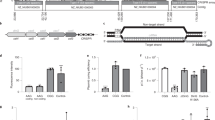Abstract
RNA interference (RNAi) has revolutionized reverse genetics in eukaryotic organisms, particularly those in which homologous recombination is inefficient or impractical. The ability to deplete or knock-down a targeted gene product without requiring genetic disruption provides a rapid means of analyzing mutant phenotypes and defining gene functions. In Histoplasma capsulatum, in vivo-produced RNA stem-loop molecules are effective in triggering RNAi of the targeted gene and the RNAi effect is both heritable and stable. The use of a green fluorescent protein (GFP) sentinel for RNAi, in which cosilencing of GFP fluorescence is used as an indicator of target gene depletion, rapidly identifies RNAi lines of H. capsulatum. Here, we describe the construction of RNAi-triggering vectors, generation of silenced lines, and utilization of the GFP sentinel RNAi system in H. capsulatum.
Access this chapter
Tax calculation will be finalised at checkout
Purchases are for personal use only
Similar content being viewed by others
References
Aliyari R, Ding SW (2009) RNA-based viral immunity initiated by the Dicer family of host immune receptors. Immunol Rev 227:176–188
Carthew RW, Sontheimer EJ (2009) Origins and Mechanisms of miRNAs and siRNAs. Cell 136:642–655
Rana TM (2007) Illuminating the silence: understanding the structure and function of small RNAs. Nat Rev Mol Cell Biol 8:23–36
Rappleye CA, Engle JT, Goldman WE (2004) RNA interference in Histoplasma capsulatum demonstrates a role for alpha-(1,3)-glucan in virulence. Mol Microbiol 53:153–165
Marion CL, Rappleye CA, Engle JT, et al (2006) An alpha-(1,4)-amylase is essential for alpha-(1,3)-glucan production and virulence in Histoplasma capsulatum. Mol Microbiol 62:970–983
Nguyen VQ, Sil A (2008) Temperature-induced switch to the pathogenic yeast form of Histoplasma capsulatum requires Ryp1, a conserved transcriptional regulator. Proc Natl Acad Sci USA 105:4880–4885
Zarnowski R, Cooper KG, Brunold LS, et al (2008) Histoplasma capsulatum secreted gamma-glutamyltransferase reduces iron by generating an efficient ferric reductant. Mol Microbiol 70:352–368
Cooper KG, Woods JP (2009) Secreted dipeptidyl peptidase IV activity in the dimorphic fungal pathogen Histoplasma capsulatum. Infect Immun 77:2447–2454
Bohse ML, Woods JP (2007) RNA interference-mediated silencing of the YPS3 gene of Histoplasma capsulatum reveals virulence defects. Infect Immun 75:2811–2817
Nemecek JC, Wuthrich M, Klein BS (2006) Global control of dimorphism and virulence in fungi. Science 312:583–588
Krajaejun T, Gauthier GM, Rappleye CA, et al (2007) Development and application of a green fluorescent protein sentinel system for identification of RNA interference in Blastomyces dermatitidis illuminates the role of septin in morphogenesis and sporulation. Eukaryot Cell 6:1299–1309
Liu H, Cottrell TR, Pierini LM, et al (2002) RNA interference in the pathogenic fungus Cryptococcus neoformans. Genetics 160:463–470
Edwards JA, Alore EA, Rappleye CA (2011) The yeast-phase virulence requirement for alpha-glucan synthase differs among Histoplasma capsulatum chemotypes. Eukaryot Cell 10:87–97
Rand KN (1996) Crystal violet can be used to visualize DNA bands during gel electrophoresis and to improve cloning efficiency. Elsevier Trends Journals Technical Tips Online:T40022
Castanotto D, Sakurai K, Lingeman R, et al (2007) Combinatorial delivery of small interfering RNAs reduces RNAi efficacy by selective incorporation into RISC. Nucleic Acids Res 35:5154–5164
Author information
Authors and Affiliations
Corresponding author
Editor information
Editors and Affiliations
Rights and permissions
Copyright information
© 2012 Springer Science+Business Media, LLC
About this protocol
Cite this protocol
Youseff, B.H., Rappleye, C.A. (2012). RNAi-Based Gene Silencing Using a GFP Sentinel System in Histoplasma capsulatum . In: Brand, A., MacCallum, D. (eds) Host-Fungus Interactions. Methods in Molecular Biology, vol 845. Humana, Totowa, NJ. https://doi.org/10.1007/978-1-61779-539-8_10
Download citation
DOI: https://doi.org/10.1007/978-1-61779-539-8_10
Published:
Publisher Name: Humana, Totowa, NJ
Print ISBN: 978-1-61779-538-1
Online ISBN: 978-1-61779-539-8
eBook Packages: Springer Protocols




